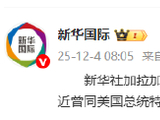Top Takes on China and the World Today

Latest Updates on Tariffs
Against the backdrop of cultural diplomacy, economic tensions simmer with the U.S. and China at its core. Former U.S. President Trump’s narrative, reported by Sing Tao, criticizes any attempts to avoid tariffs on unfair trade practices, specifically singling out China. His posts on Truth Social emphasize the U.S.'s stance on recalibrating trade balances perceived as unfavorable. This rhetoric is indicative of the ongoing trade conflicts and highlights strategic economic posturing as both nations navigate these disputes. U.S. President Trump's comments about ongoing tariffs reveal an enduring trade rift between China and the U.S. He denied the news of tariff exemptions, insisting that no nation, particularly China, should evade tariffs meant to address trade imbalances and currency manipulations.
Adding to this, the implications of the U.S. setting specific tariffs on semiconductors and tech products from China are profound. The ramifications extend beyond bilateral trade, affecting global supply chains and tech sovereignty. The United Daily News reflects on how these measures are not just temporary but part of a broader strategy to ensure U.S. dominance in critical technologies, a sentiment echoed by economic analysts here. This is a critical issue as tech nations around the world must navigate the choppy waters of U.S.-China tech competition, influencing sectors from manufacturing to AI development.
Absence of Sino-American Dialogue
The United Daily News focuses on the diplomatic gridlock between the U.S. and China. With no plans for dialogue between leaders, tensions simmer without resolution. Jamieson Greer, the U.S. Trade Representative, notes the heightened trade war tensions, attributing the lack of progress to China's retaliatory measures.
This highlights a broader strategic contest, where both nations' trade policies seek leverage rather than compromise. Greer's emphasis on U.S. manufacturing and trade flow realignment reflects an American strategy to reduce dependency on China, a sentiment echoed globally as nations navigate their own economic security paradigms.
Noteworthy is the absence of concrete communication, indicating a tactical pause or recalibration by China, perhaps awaiting a broader geopolitical shift or ensuring national interests align with long-term global strategies. The absence of dialogue highlights complexities in reconciling the intertwined economic interests that both nations share.
China's Response to U.S. Tariffs
China's Ministry of Commerce, as covered by People's Daily, takes a measured stance in response to recent U.S. tariff exemptions on select products, framing it as a step toward correcting previous trade policy errors. This narrative underscores China's strategic diplomacy, advocating for a mutual respect-based conflict resolution. China's response is not only geared toward easing bilateral tensions but also sending a signal to global markets about its commitment to stabilizing international trade relations.
China's Strategic Tie-ups in Southeast Asia
Meanwhile, China continues to fortify its Southeast Asian relationships, a strategy detailed in a People's Daily article. Chinese President Xi Jinping’s visits to Vietnam, Malaysia, and Cambodia underscore a continued push for deepened strategic partnerships. These trips come amid a belt of regional and economic development projects that amplify China's influence in the region.
People’s Daily highlights these visits not only as diplomatic gestures but as foundational steps towards enhancing the China–ASEAN community’s cooperative framework. A theme that resonates throughout the report is the intertwined destinies of these nations, with China emphasizing its commitment to regional stability and prosperity through shared development initiatives. The narrative propagates an image of benevolent regional leadership, seeking to chart a course for collaborative growth in politically tense times.
These initiatives in Southeast Asia are strategic and multidimensional, encompassing infrastructure, education, technology, and cultural exchanges, reflecting China's growing global footprint and the soft power applications of its Belt and Road Initiative.
Diplomatic Bonds Deepen between China and Vietnam
Recently, Chinese President Xi Jinping visited Vietnam, underscoring the close ties between the two socialist countries. According to Sina, this visit commemorates the 75th anniversary of the establishment of diplomatic relations between China and Vietnam, highlighting their shared revolutionary history and deep-rooted ideological alignment. Xi's article published in Vietnam's People's Daily expressed a commitment to advancing the 'China-Vietnam community of common destiny.' This concept is not novel but has been revitalized to manage regional stability in light of global uncertainties.
The consistent narrative across different Chinese media outlets emphasizes a shared future and cooperative prosperity. While Sina's coverage lauds this political camaraderie, it contrasts significantly with international views, which may critique China's motivations as strategic rather than purely cooperative.
China at the Osaka Expo 2025
The Osaka Expo 2025 has garnered significant attention with the launch of China’s pavilion. CCTV's coverage underscores the grandeur of the exhibit, noting its expansive area of 3,509 square meters, making it one of the largest international pavilions at the Expo. Themed ‘Harmony Between Heaven and Humans’, the exhibit integrates traditional Chinese aesthetics with cutting-edge technology, showcasing the nation's dedication to ecological wisdom and green development principles. This representation aims not merely to display Chinese culture but to strengthen Sino-Japanese cooperation as emphasized by CCTV.
The People's Daily’s report on the Expo provides a complementary perspective, highlighting the importance China places on this event to promote international dialogue and understanding. The Expo’s theme of innovation and cooperation reflects a shared vision between China and Japan for a sustainable future, fostering multilateral partnerships. The celebration features traditional performances such as lion dances, which serve as cultural bridges for international audiences, as noted in People's Daily. Both articles emphasize China’s global cultural diplomacy and its efforts to foster multilateral economic and cultural exchanges. The pavilion acts as a testament to the increasing importance of soft power in international relations.
Technological Breakthroughs at the Forefront
In a display of technological prowess, China successfully launched its Long March 3B rocket, deploying the communication satellite TechSat-17 into orbit. This mission exemplifies China's growing capabilities in space technology, leveraging innovations to enhance satellite communication infrastructure. Such advances highlight China's strategic investments in high-density satellite launches, an area where they are rapidly closing in on peers like the United States.
Similarly, China has achieved significant strides in underwater oil extraction technology, with the effective deployment of the first self-developed deepwater subsea oil tree. As covered by Sina, this development is crucial for ensuring China's energy security. Furthermore, the focus on races like the Long March and domestic technological applications underscores China's multi-faceted approach to securing its strategic needs.
Advancements in Space and Maritime Technology
China has made notable strides in space technology as evidenced by the successful launch of the Long March-3B rocket, which deployed a communications satellite into orbit. This achievement, covered by Sina, marks a significant step in enhancing China’s satellite communications capabilities, specifically targeting improvements in multi-band, high-speed satellite communication technology. This progress positions China as a competitive player in global space technology. In a parallel development, China has also overcome significant engineering challenges by successfully deploying its first deep-water subsea oil tree, a critical technology for offshore oil and gas extraction. This innovation showcases China's growing expertise in maritime technology, promising to boost energy security and exhibit China's capacity for technological solutions in challenging environments (Sina).
Renewable Energy and Infrastructure Innovation
China is pioneering in the field of energy storage with the completion of its first hybrid intelligent energy storage project. This ambitious initiative integrates cutting-edge technologies such as lithium-ion, flow batteries, and flywheel storage to create an efficient, high-capacity energy storage system. The Sina reports emphasize the project's significant strides in energy conversion efficiency and cost reduction, propelling China to a leading position in energy transformation imperatives. Furthermore, the successful deployment of the largest shield tunnel boring machine in Southwest China, as reported by Sina, supports major water diversion projects critical for water resource management. These infrastructures reflect China's commitment to sustainable development and resource management.
The Rising Energy Demands of AI Data Centers
The global implications of expanding AI data needs are profound, as highlighted by Xinhua's report on increasing energy consumption by data centers. Globally, the energy demand for these centers is set to more than double by 2030, posing significant challenges to energy security and carbon emissions reduction targets.
With an illustrative example that a large data center's power requirement could potentially supply tens of thousands of households, the strain on the energy grid is inevitable. Countries are attempting to upgrade electricity supply infrastructures, yet bottlenecks such as grid delays could impede timely expansions. This might push for aggressive innovations in energy efficiency, renewables integration, and possibly the adoption of cutting-edge cooling solutions to mitigate environmental impacts.
Smart Agriculture: AI Robots in Tea Harvesting
A transformation in agriculture is underway, led by AI-driven harvesting robots in Chongqing's tea fields. These robots represent an innovation addressing traditional manual labor shortages, offering precision and efficiency. Capable of operating continuously and achieving high accuracy in picking tea leaves, they reflect a meaningful intersection of AI and traditional agriculture. This innovation aligns with broader rural revitalization efforts by injecting technology into conventional industry, suggesting that even deeply traditional sectors can benefit from AI integration. As the world looks to food security and sustainable practices, these advancements could redefine agricultural labor efficiency and environmental impact perceptions, offering a template for similar initiatives globally.



